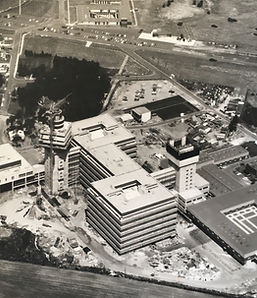
The History of Adastral Park
Adastral Park, located in Martlesham Heath, Suffolk, has played a crucial role in the UK's telecommunications research and development for several decades. But the site has a long and storied history that predates its recognition as a hub for technological innovation.
Long before the arrival of the Post Office Research Station, now known as Adastral Park, Martlesham Heath was known for its airfield. During the First World War, it served as an aircraft testing site for the Royal Flying Corps, later becoming the Royal Air Force (RAF) Aeroplane Experimental Unit. It played a significant role in the development and testing of new aircraft, and also served as a defensive station during both World Wars.
In the interwar years, the airfield was home to the Aeroplane and Armament Experimental Establishment, where testing of many aircraft designs took place. During the Second World War, Martlesham Heath was used by both the RAF and the United States Army Air Forces.
After the war, the airfield was used for various purposes, including as a home for the Atomic Weapons Research Establishment, before eventually being decommissioned in the 1960s. The establishment of the Post Office Research Station in 1975 marked the beginning of a new chapter in the history of Martlesham Heath, transitioning from aviation to telecommunications.
The site was developed in 1975 as the Post Office Research Station, when the Post Office's research department was relocated from Dollis Hill in London. The move to Martlesham Heath was aimed at providing a more spacious and modern research environment.
In its early years, the site's research focused on telecommunications, with projects including the System X digital exchange and early fibre optic communication systems.
In 1981, following the privatisation of the telecommunications industry, the site was taken over by British Telecom (BT), and it continued to serve as the company's main research and development centre. The location was renamed Adastral Park in 1999, a name derived from BT's motto "Ad Astra", meaning "to the stars".
Since then, Adastral Park has grown into a thriving technology hub, hosting not only BT's research but also numerous other tech companies and startups. The site has been instrumental in developing many technologies that underpin modern telecommunications, such as fibre optic cables, broadband internet, and wireless communication technologies.
Adastral Park continues to be a leading centre for technological innovation, with a particular focus on emerging areas such as 5G, artificial intelligence, and cybersecurity.

The Construction of the Site
The design and construction of the General Post Office (GPO) Research Labs at Martlesham Heath, Suffolk, represented a significant commitment by the UK government to advance the country's telecommunications technology. The decision to move from the previous location at Dollis Hill to Martlesham Heath was driven by the need for a more spacious and technologically advanced facility.
The design of the new research station was carefully planned to facilitate cutting-edge research and development. It was built with modern laboratories and equipment to support the work of scientists and engineers. The site's layout was designed to encourage collaboration and the free exchange of ideas, essential for innovation.
Construction began in the early 1970s, and the facility was officially opened in 1975. The building was a notable example of the modernist architectural style of the time, featuring a utilitarian design that emphasised functionality.
The facilities at the GPO Research Labs were continually updated to keep pace with the rapid advances in technology. The initial focus of research at the site included the development of the System X digital exchange and early work on fibre optic communication systems.

The Official Opening in 1975
The Post Office Research Station at Martlesham Heath, Suffolk, was officially opened in 1975 by Queen Elizabeth II. This marked a significant development in the UK's telecommunication sector. The research station was designed to be a state-of-the-art facility for the advancement of post and telecommunications technology. The move from the previous location at Dollis Hill, London, to the spacious site at Martlesham Heath, provided researchers with modern facilities and more room for expansion. Research initially focused on telecommunications, including the System X digital exchange and early fibre optic communication systems, paving the way for the next generation of telecommunications technology.
The GPO Research Labs

The General Post Office (GPO) Research Labs, established in Martlesham Heath, Suffolk in 1975, served as a key innovation hub for UK telecommunications. Scientists and engineers at the labs worked on a variety of projects to enhance the country's telecommunications infrastructure. Notable projects included the development of System X, a digital telephone exchange system that was one of the world's first to be controlled by a computer. The labs also conducted crucial research on fibre optic communications, which would revolutionize global telecommunications. The work at GPO Research Labs laid the groundwork for many advancements in the telecommunications sector.
Adastral Park

The transition from the General Post Office (GPO) Research Labs to Adastral Park was a significant milestone in the UK's telecommunications history. After the privatisation of British Telecom in 1981, the Martlesham Heath site became BT Laboratories. It continued as a pivotal site for telecommunication research, driving numerous technological advancements. In 1999, it was rebranded as Adastral Park, derived from BT's Latin motto "Ad Astra", meaning "to the stars". The park expanded beyond BT's own research, welcoming other tech companies and startups. This transformation symbolised the shift from traditional telecommunications research to a broader focus on digital technologies.
Contact
For more info contact info@chroniclestories.co.uk
